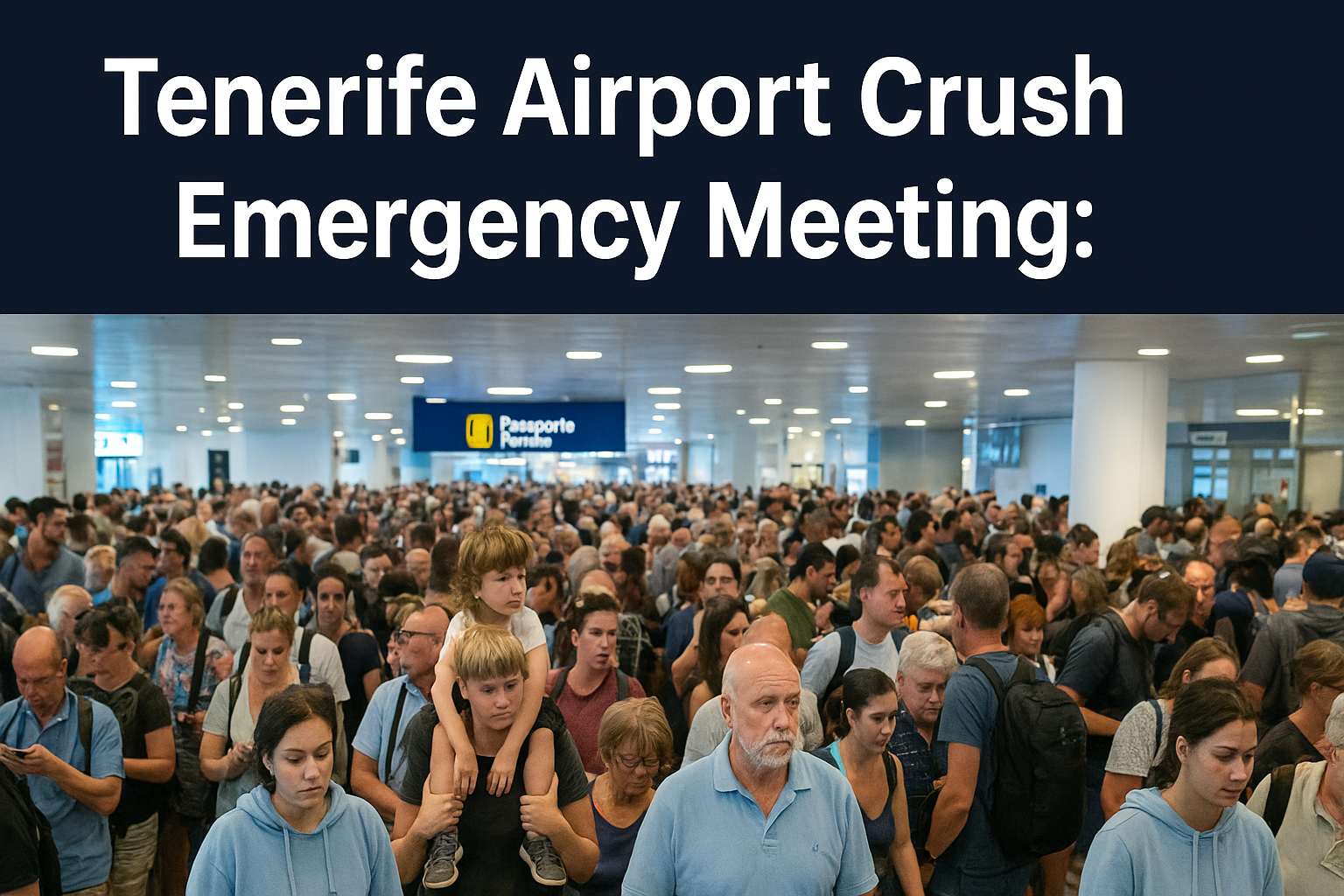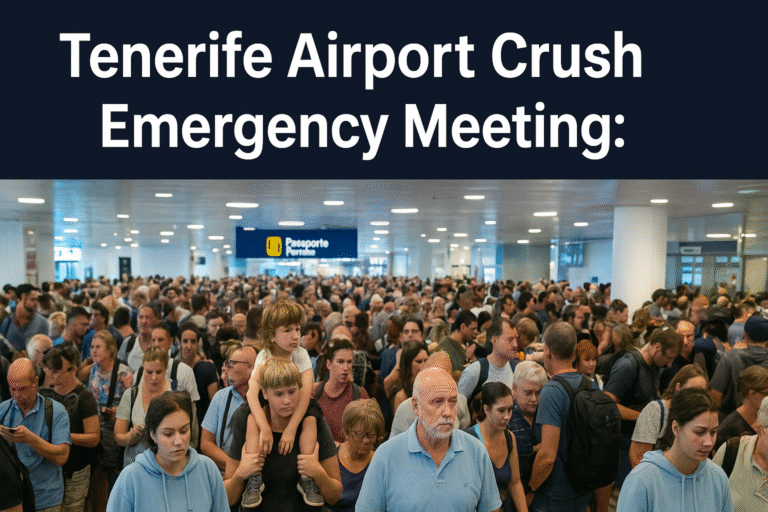
The Tenerife Airport Crush Emergency Meeting has become one of the most talked-about crisis responses in the aviation and tourism industries this year. It was not just an administrative meeting — it was a call for immediate action following scenes that shocked both passengers and authorities at Tenerife South Airport, one of Spain’s busiest entry points for tourists from across Europe.
The situation unfolded when thousands of passengers, mainly from the United Kingdom, arrived almost simultaneously on multiple flights. Due to limited border control staff and restricted space, the arrivals hall turned into a suffocating crush, leaving many travelers trapped for hours. The images and videos that circulated on social media showed chaos, distress, and panic, prompting Tenerife’s government to demand an urgent solution.
The Tenerife Airport Crush Emergency Meeting was convened by island president Rosa Dávila and attended by representatives from Spain’s Ministry of the Interior, the airport operator AENA, tourism officials, and local law enforcement. The meeting’s objective was simple but vital: to find out how one of Europe’s top tourism destinations could descend into such disorder — and to ensure it never happens again.
What Triggered the Tenerife Airport Crush Emergency Meeting
In late May 2025, Tenerife South Airport experienced an overwhelming influx of passengers from the UK and other European countries. Several flights landed within a short window, but passport control had only a few officers available. Because post-Brexit travelers from the UK now require manual passport checks and stamping, processing times per person have significantly increased.
With only a handful of immigration desks open, passengers quickly filled every available space inside the arrivals hall. What began as long queues escalated into an unsafe crush, where movement became nearly impossible. Eyewitnesses described children crying, elderly passengers feeling faint, and no access to water or restrooms. Many travelers reported being stuck in the hall for up to two hours.
Local media labeled the event “inhumane,” while politicians called it a disgrace to Tenerife’s international image. These reports, combined with global media coverage, forced local authorities to act immediately — leading to the Tenerife Airport Crush Emergency Meeting.
The Response from Tenerife’s Government
President Rosa Dávila condemned the situation as “unacceptable and dangerous.” She emphasized that this was not an isolated incident but part of a recurring pattern at Tenerife South Airport. The island’s leadership had previously requested additional national police officers for border control, especially during high tourist seasons. However, those requests had not been fulfilled.
During the Tenerife Airport Crush Emergency Meeting, Dávila urged Spain’s central government to take immediate responsibility. “Tenerife cannot be left alone to manage the consequences of national policy,” she said. Her comments reflected growing frustration that decisions affecting border operations are controlled from Madrid, while the consequences are felt locally on the island.
Tourism Councillor Lope Afonso also stressed that the airport’s condition directly affects Tenerife’s economy. Tourism represents nearly 40% of the island’s GDP, and any perception of chaos at entry points could discourage visitors. He demanded not only more personnel but also long-term investment in infrastructure and technology.
What Passengers Experienced During the Chaos
Accounts from passengers were alarming. Families traveling with small children described feeling trapped in a “human bottleneck.” Some elderly tourists required medical assistance after standing for long periods in hot, crowded conditions. Others said there was no visible airport management presence to provide guidance or crowd control.
Several travelers reported being kept on aircraft for 30–45 minutes before being allowed to disembark because the terminal could not handle additional arrivals. Once inside, there was no clear signage or queue management, and announcements from airport staff were either inaudible or nonexistent.
These experiences were shared widely online, sparking outrage and raising serious concerns about safety and the quality of Tenerife’s visitor management systems.
National Government’s Reaction
Following the widespread media coverage, Spain’s Ministry of the Interior acknowledged the incident and promised to review staffing levels at Canary Islands airports. Officials admitted that post-Brexit procedures have significantly slowed down entry processing for British travelers, who make up over 40% of Tenerife’s international visitors.
However, critics argue that the response has been too slow. Tenerife’s leaders maintain that they have repeatedly requested additional resources over the past two years without adequate results. The Tenerife Airport Crush Emergency Meeting was therefore seen as both a crisis summit and a political confrontation between local and national authorities.
Structural and Operational Causes
The meeting identified several key issues that contributed to the airport crush:
-
Understaffing at Passport Control:
Despite high passenger volumes, only two to three passport booths were operational during the incident. Dozens of passengers per flight and multiple simultaneous arrivals overwhelmed the system. -
Inadequate Infrastructure:
Tenerife South Airport, though modernized in recent years, was not designed to handle current peak-season demands. Narrow corridors and limited waiting areas created unsafe crowding. -
Post-Brexit Documentation Requirements:
British passengers now require additional border checks, which can double processing time. With the UK remaining Tenerife’s largest tourism market, this procedural change has major operational impacts. -
Lack of Contingency Planning:
The absence of rapid response mechanisms — such as calling in additional staff or opening overflow areas — allowed a manageable delay to escalate into a crisis. -
Poor Communication:
During the incident, passengers reported little information or coordination from airport staff. This lack of communication increased panic and frustration.
The Broader Impact on Tenerife’s Image
Tenerife’s reputation as a welcoming, efficient tourist destination has taken a hit. Global coverage of the airport chaos risks discouraging travelers, particularly families and older tourists who prioritize comfort and safety.
Tourism organizations warn that even a single negative viral incident can influence travel decisions. Competitor destinations, such as Portugal’s Madeira or mainland Spain’s Costa del Sol, could benefit from Tenerife’s reputational damage if corrective measures are not swiftly implemented.
The Tenerife Airport Crush Emergency Meeting therefore carries economic importance as well as operational urgency. The island’s leaders are determined to prove that Tenerife remains a world-class destination capable of learning from setbacks.
Proposed Solutions from the Emergency Meeting
During the Tenerife Airport Crush Emergency Meeting, participants agreed on several short- and long-term actions:
-
Immediate Reinforcement of Staff:
Additional national police officers and immigration agents will be deployed during peak travel periods. -
Improved Coordination with Airlines:
Airlines will be required to share more precise arrival schedules and passenger volumes, allowing border control to prepare accordingly. -
Expansion of Automated Systems:
New e-gates and biometric verification systems will be installed to streamline passenger processing without compromising security. -
Infrastructure Improvements:
Plans are underway to expand the arrivals hall, improve ventilation, and add emergency exits to prevent future crush risks. -
Crisis Management Protocols:
A dedicated command center will be established to monitor passenger flow in real time and respond rapidly to surges. -
Public Communication Strategy:
Real-time updates will be provided to passengers through airport screens, announcements, and mobile applications to reduce uncertainty during delays.
Looking Ahead: Lessons from the Tenerife Airport Crush
The Tenerife Airport Crush Emergency Meeting serves as a reminder that even world-renowned tourist destinations are vulnerable to systemic weaknesses. In an age of increasing travel demand, airports must evolve beyond traditional staffing and infrastructure models.
Tenerife’s experience highlights the need for better coordination between local and national governments, smarter use of data, and adaptive staffing models that respond to real-time passenger volumes. It also underlines the importance of transparency and empathy in crisis management — travelers are more forgiving when they feel informed and cared for.
If Tenerife successfully implements the reforms discussed during the emergency meeting, the crisis could become a turning point rather than a permanent scar. With strong leadership, investment in technology, and a renewed commitment to passenger safety, Tenerife South Airport can rebuild its reputation as a gateway of efficiency and hospitality.
Read also: Exploring the Hidden Mysteries of Plum Island Southold, NY 11957
Final Thoughts
The Tenerife Airport Crush Emergency Meeting was more than an administrative necessity; it was a defining moment for the island’s aviation and tourism sectors. The meeting acknowledged hard truths about infrastructure, staffing, and coordination, but it also paved the way for transformation.
Tenerife’s leaders, airport authorities, and Spain’s central government now face a clear choice: to act decisively or risk repeating the chaos that shocked travelers and tarnished the island’s image.
The world is watching how Tenerife responds. If it succeeds, the island can emerge stronger, safer, and more resilient — turning crisis into opportunity and ensuring that future visitors arrive to experience paradise, not panic.



